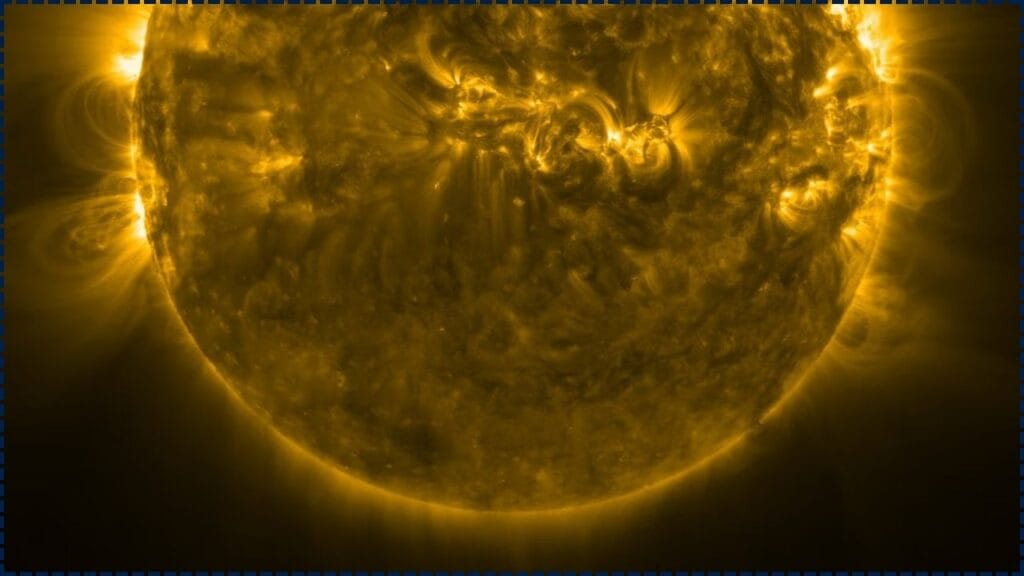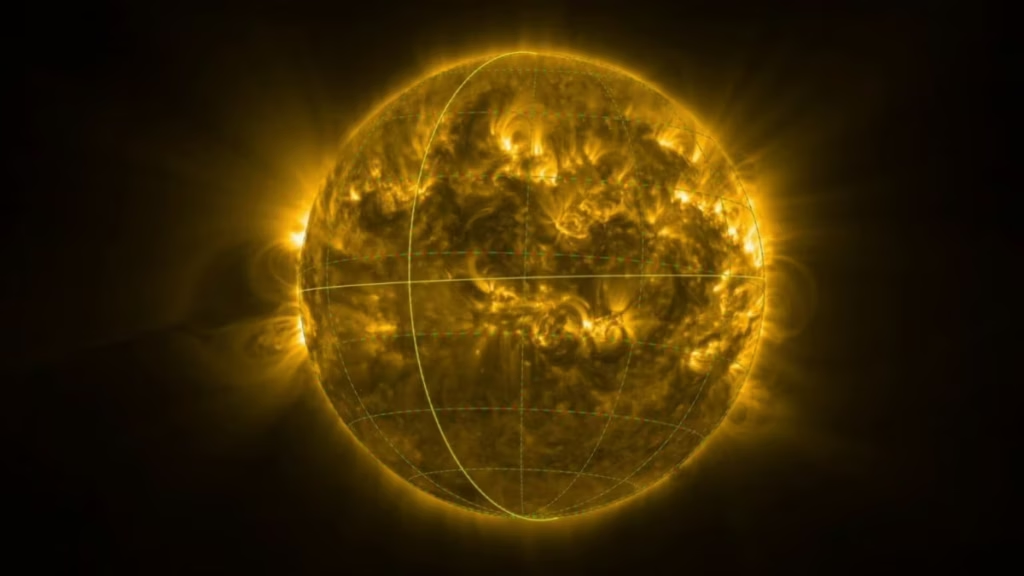This is truly headline news from space, folks! In March 2025, a special spacecraft called the Solar Orbiter, a joint effort by the European Space Agency (ESA) and NASA, achieved something incredible. It dipped significantly below the Sun’s equator, reaching a tilt of 15° to 17°, and for the first time ever, it captured up-close images of the Sun’s mysterious South Pole.

This wasn’t an easy task, and it’s a huge step forward in how we understand our closest star. Seeing the Sun’s South Pole directly allows scientists to gather completely new information. This helps us better understand the Sun’s powerful magnetic field, which plays a vital role in creating space weather that can affect Earth. By learning more about these previously hidden regions, we can improve our ability to predict solar events, ultimately helping to protect our technology and astronauts. It’s a remarkable achievement that benefits everyone on our planet by deepening our knowledge of the universe.
Before this, all our sun pics came from near the equator—like always sitting on the same bench at a game day. This mission? They climbed higher and got a fresh angle. Now we’re seeing regions nobody’s laid eyes on before.

Rare First-Ever Glimpse of the Sun’s South Pole
| Aspect | Details |
|---|---|
| Mission | Solar Orbiter, ESA–NASA solar mission launched Feb 2020 (en.wikipedia.org) |
| Tilt & Imaging | First south pole pics captured March 16–17, 2025 at ~17° tilt |
| Instruments Used | PHI (magnetic mapping), EUI (ultraviolet corona), SPICE (plasma velocity/composition) |
| Magnetic Findings | “Magnetic mess”: mixed polarity fields as solar maximum and polarity flip begin |
| Sun’s Cycle Stage | Approaching solar maximum of 11‑year cycle, flip underway |
| Space Weather Impact | Better polar data means improved forecasts for solar storms affecting satellites, power, communications |
| Future Plans | Further tilts via Venus flybys—24° in late 2026, 33° by 2029—to image north pole too |
| Official Reference | ESA Solar Orbiter mission page |
This is a truly historic moment for all of us! The Solar Orbiter spacecraft has captured the first-ever images of the Sun’s mysterious South Pole. This incredible achievement opens up a vital window, allowing us to see the magnetic chaos happening at the Sun’s most active period, called solar maximum. More importantly, this new view will greatly improve our ability to predict space weather, which can impact our technology and even astronauts here on Earth.
The amazing teams at the European Space Agency (ESA) and NASA who designed this mission embody a beautiful Native American guiding principle: to look beyond what is obvious, to honor the unseen patterns that shape our world, and to share discoveries that make our connection with Earth stronger. As we look forward, even more exciting discoveries are on the horizon, with views of the Sun’s North Pole and deeper insights into its swirling solar secrets yet to come. It’s a powerful reminder of how curiosity and collaboration can lead to discoveries that benefit everyone.
Why This Discovery Matters
Opens Up New Frontiers (“Terra Incognita”)
For decades, the Sun’s poles were hidden from view. Solar Orbiter’s tilt lifted that restriction for the first time. (space.com)
Confirms Magnetic Predictions
PHI captured a tangled mix of north and south magnetic fields at the south pole—exactly what scientists expected during solar maximum. (esa.int)
Boosts Space Weather Models
Solar flares and plasma storms follow magnetic field lines from the poles. Now, forecasting can get more accurate, protecting everything from power grids to satellite networks.
Provides Global Solar View
With continued mission tilts, Solar Orbiter will chart both poles—giving a complete picture of solar dynamics and the 11-year cycle.
Rare First-Ever Glimpse of the Sun’s South Pole Mission Journey
- Launch & Cruise (2020–2021): Launched Feb 2020; by late 2021 it began science operations. Uses Venus flybys to tilt orbit.
- Pole‑Tilting Achieved (Mar 2025): March 16–17, orbiter reached 17° tilt—first direct look at south pole. PHI, EUI, SPICE instruments swung into action.
- Data Hit Earth (June 2025): High-resolution images and magnetic/velocity maps released, stunning the world.
- Mission Continues: Aiming for 24° tilt via Venus end‑2026, then north pole pass; full pole-to-pole expected by 2029.
A Native‑Inspired View
In many Native teachings, true wisdom comes from a beautiful balance between what we can see with our eyes and what remains unseen, always deeply honoring the powerful cycles of nature. The incredible journey of the Solar Orbiter spacecraft, as it ventures close to our Sun, truly echoes this ancient tradition. It’s going beyond what’s plainly visible, revealing the hidden workings of our closest star.
These amazing discoveries about the Sun invite us to think about our own lives in a new way: to live in harmony with cosmic rhythms. Just as the Sun influences life on Earth in countless ways, there are many unseen forces both in the universe and in our own world that shape our experiences. By appreciating these grand connections, we can foster a deeper respect for all of life and our shared home in the cosmos.
FAQs
Q: Why couldn’t we see the Sun’s poles before?
All earlier spacecraft stayed within ~7° of the Sun’s equator—the ecliptic plane. Only with orbital tilt could poles come into view.
Q: What did PHI, EUI, and SPICE record?
- PHI mapped visible magnetic fields
- EUI captured ultraviolet corona images
- SPICE showed plasma motion and composition via spectrometry.
Q: What’s solar maximum and why does it matter?
Around every 11 years, solar activity peaks—magnetic fields flip polarity. This period sees more flares and plasma storms. The south pole shows the chaos as the flip happens.
Q: How does this affect Earth?
Solar storms from pole regions can disrupt satellites, power grids, GPS, radio—and even harm astronauts. Better pole data = better forecasts.
Q: What comes next?
Watch for north pole images in coming years after orbit reaches ~24° and then ~33°. Full magnetic cycle mapping expected by late 2020s.








